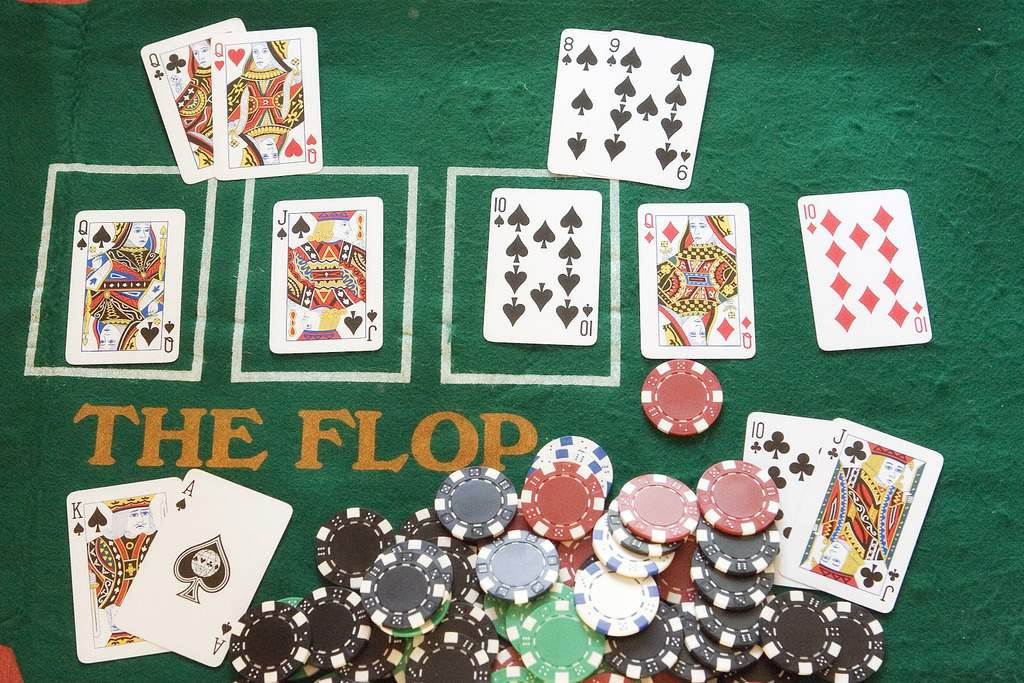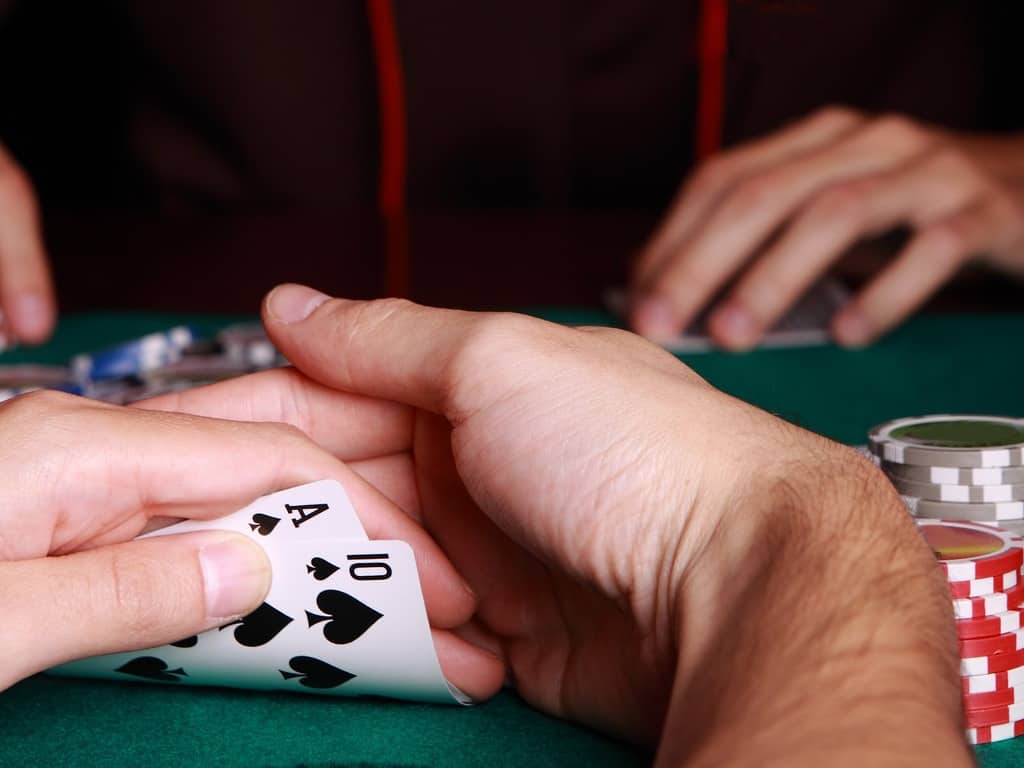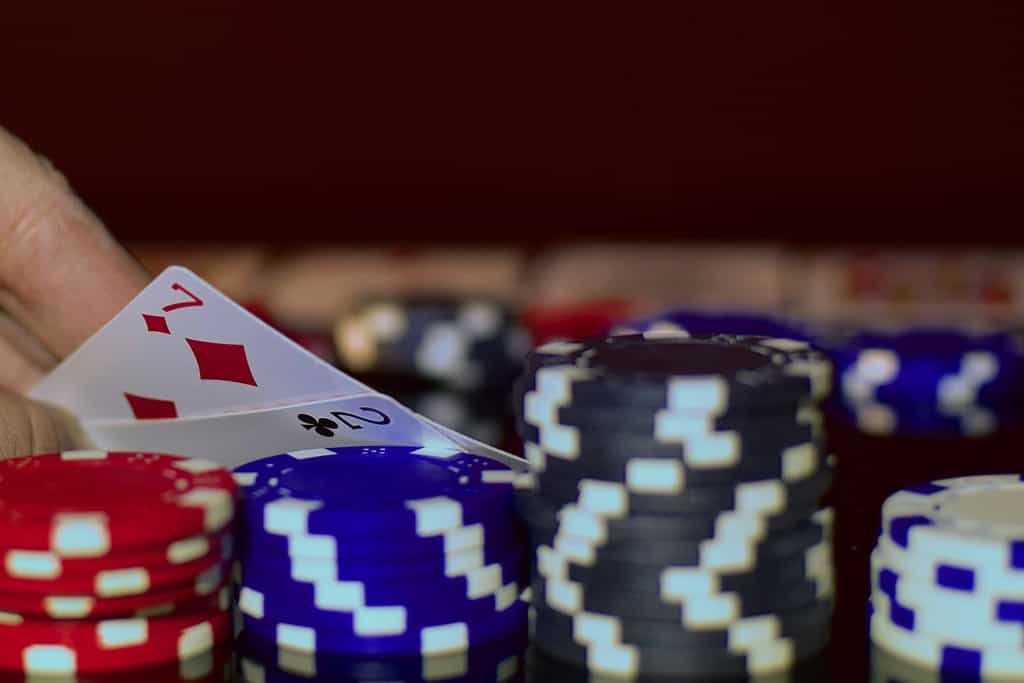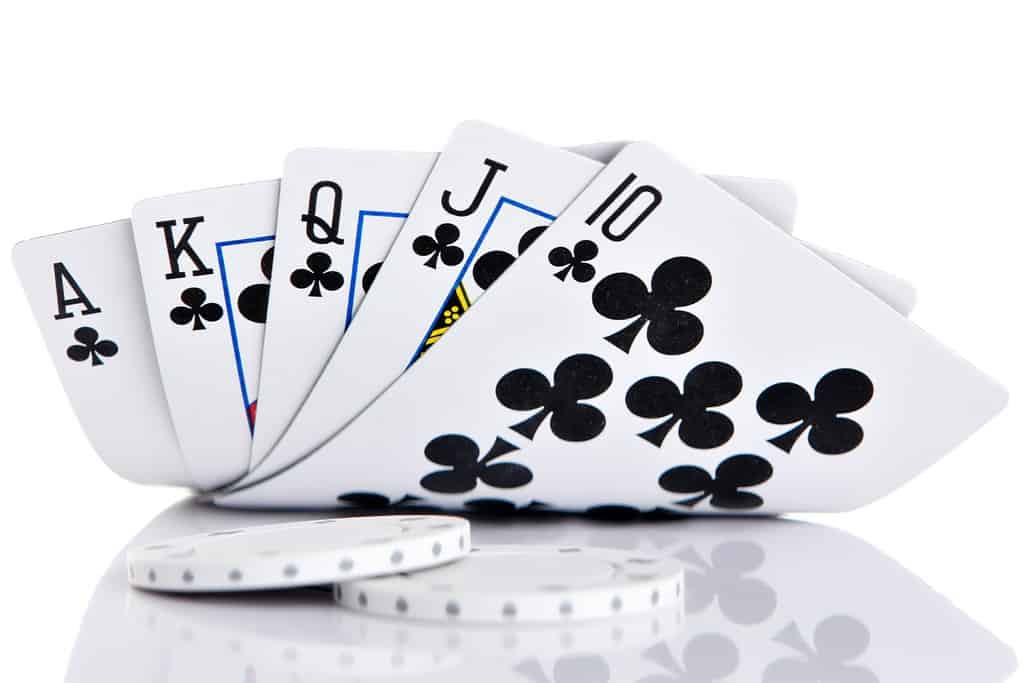11 Poker Lessons for New Players
Whether you’re a beginner in search of some basic tips or a seasoned pro looking to sharpen your fundamentals, this post is for you. We’ve broken down the 11 essential lessons of poker that will turn you into a winning player. We will look in-depth at some of the most important pre-flop and flop strategies that will help you feel more confident at any poker table.
Lesson 1: Pre-Flop Hand Analysis

(Source: Stock.adobe.com)
Believe it or not, the first decision a player makes in a hand is the most important: call, raise or fold. Understandably, many beginner players will look at their hole cards without fully understanding the value of their holdings and make the most common mistake: playing too many hands. How do winning poker players evaluate hands pre-flop?
- Ranking (Ace is high, deuce is low.)The higher ranked the cards, the higher your chances are of making the best hand. If you have a hand like AK, and you make top pair, chances are you will win. But if you have a hand like J10 and make top pair then winning the pot is not as likely.(A note on pocket pairs: The lower ranked pocket pairs are good to play cheaply to try and hit a set on the flop. The higher ranked pairs are good to play simply because they will often beat your opponents’ holdings and you won’t need to hit any board cards to win the pot.)
- Connectedness (Are they connected, i.e. 67?)Connected cards are better than unconnected cards because they increase your chances of winning the pot by making a straight.
- Suitedness (Are the hole cards the same suit?)Suited cards are better than unsuited cards because they increase your chances of winning the pot by making a flush.
So, the ideal pre-flop hand would either be a high pocket pair or a high ranking, suited and connected hand like AKs. The more hands you play with all three attributes in position, the more money you will make in the long run.
Lesson 2: Positional Awareness
Positional awareness is something frequently discussed in poker forums and even at the poker table nowadays. It would be unusual to leave a poker room without hearing players discussing early position, late position, middle position, in position, and/or out of position. But what does it all mean?
Position refers to your seat relative to the dealer button. If you are closer to the dealer button than your opponents, then you are “in position.” If your opponents are closer, you are “out of position.” Similarly, you are in early position if you are far away from the button, and late position if you are close to the button (looking at the table clockwise).
Position has several implications, the most important of which is that players closer to the button have more information than players farther away from the button. If you were playing in position, then every round of betting you would get to see what your opponents do before you decide what to do and vice versa.
Winning players tend to play more hands in position and fold much more often out of position. But which exact hands do they open and how do these hand ranges differ for each position?
Lesson 3: Hand Selection

(Source: Stock.adobe.com)
To determine which hands to play, a player must consider a few factors such as stack sizes (big or small), villain tendencies (loose or aggressive), number of players, game flow (Are you on a heater? Did you recently show a bluff?) and most importantly, position.
The tightest open raising range—the position which players should play the fewest amount of hands from—is the UTG position, and the loosest is usually from the button.
A standard UTG open in a 6-max game is 55+, AT+, KT+, QTs+, J9s+, 97s+, 76s+, AJo+, KQo
A tight button open is 22+, A2s+, K9s+, Q9s+, J8s+, T9s+, 45s+, A8o+, KTo+, QTo+, 98o+.
That means, on average, a good player will only be playing about 13% of the hands they get UTG. On the button, you should strive to open raise about 50% of the time and if action is folded to the blinds, then you should raise as much as 70%. The closer you are to the blinds, the more often you should be open raising. A HUD like Poker Copilot can help keep track of your pre-flop raising percentage to ensure you are opening at the correct frequency.
If you wanted to approximate a solid middle position opening range, take the UTG opening range we’ve shown and add a few high ranked, suited, connected cards, and the rest of the pocket pairs like pocket 2’s, 45s and KJo.
Other factors that we have already mentioned will also widen or narrow your opening range. For example: if there are more players in the hand, if the players are aggressive, if your stack is short, if you’ve recently shown a bluff or recently lost a big hand, then you should open tighter.
A note about calling: Limping in preflop is generally discouraged for several reasons. We advise you to open raise any hands you want to play. But sometimes your opponents raise, and you have a good hand. The principles that determine whether you should open pre-flop are the same as those for whether or not to call with a few small differences. A general rule of thumb is to fold the weakest hands in your opening range, call with the middle of your range, and re-raise with the top of your range. For example, if you’re in MP and the UTG player raised, then you would now fold kjo/56s but call with hands like 77-JJ/AJo and raise QQ+/AQs+.
Lesson 4: Blind Stealing
What drives any poker game? What would happen if players sat down at a table that didn’t require the constant mundane placement of small and big blinds every round? There would be no reason to play any hand other than pocket aces. That’s because it’s the most profitable hand and you don’t stand to lose anything from continually folding.
The small and big blinds are what drive a poker game. Players cannot sit and wait for the best hand simply because they would run out chips before they got dealt aces. Blinds mean that all players need to play sub-optimal hands at times and they don’t always make the right decisions: particularly from the blinds.
Players in the blinds have already put money in the pot without seeing their cards and therefore often have weak holdings. Good players will take advantage of this by stealing the blinds. They will open raise with some weak holdings in late position, hoping that the blinds will either give up or fold later in the hand.
Of course, we cannot do this constantly because the blinds will catch on to our strategy, start to re-raise us and make us fold. But with a delicate balance, we can make free money by raising with weak holdings every so often.
Lesson 5: Why Do We Bet?
It seems like a silly question – why do we bet? Think about it a little. Maybe the first response that comes to mind is “because I have a good hand” or “because I’m bluffing.” While these are close to the real answer, they are somewhat amiss.
The truth is there are fundamentally two reasons to bet: to get an inferior hand to pay you money or to get a better hand to fold. In poker terms, we are always value betting or bluffing, each time we bet.
Value betting is when you have a strong hand preflop, such as AQs, or a strong hand post flop, like a straight, and bet. You want people with weaker hands to call you so that in the end you can show your big hand and take down a nice pot.
Bluffing is when you have a weak hand and bet in the hope the other players will fold their hands, which are presumably better than your holdings.
Whenever you are thinking about whether or not to bet, always remember to ask yourself if you’re value betting or bluffing. If it’s neither, you should probably check.
Lesson 6: Bluffing

(Source: Stock.adobe.com)
Don’t do it often. Period. One of the biggest beginner mistakes is bluffing too much. That’s because novices don’t know when to bluff yet, they haven’t learned about poker tells and how to narrow their opponent’s ranges, nor do they use a HUD.
If you bluff, do it pre-flop on the button when the pot hasn’t been raised yet. In this scenario, your bluff has the highest likelihood of success. Your opponents either limped or folded (therefore they have weak holdings) and you have position, so you will continue to play your hand on the following betting rounds with more information than your opponents.
Lesson 7: C-Betting
Also known as a continuation bet, this is when a player raises pre-flop and then continues to bet on the flop. This has become such a common practice that, on the flop, you can expect most players to always check to the pre-flop raiser, expecting them to c-bet.
But if a player is constantly c-betting, won’t they be bluffing most of the time? Having a value hand by the flop is unusual. So, when is it a good time to c-bet?
C-betting is a finely-tuned skill and is covered more thoroughly in an earlier post. The most important factors are the number of opponents, your image, your cards, your position, the board, and the reads on your opponents.
You want to be c-bet bluffing most frequently when there aren’t many opponents, you have a winning image, have missed the flop, in position, and the board has some high-ranking cards. For example, we have 78s on Ad Ts 5h flop
You want to c-bet for value when there are several opponents, you have medium to bad image, have hit the flop, in any position, and the board has some lower cards that your opponents likely hit or has some kind of draw. For example, we have AKo on Ks Js 8h.
Lesson 8: Bet Sizing

(Source:: Stock.adobe.com)
We’ve all had that lingering question in the back of our minds as we reach for the chips: “How much should I bet?”. Bet sizing is a particularly important skill to develop and takes years to fine-tune, but here is an introduction.
Bet sizing varies on the betting round, how much money is in the pot, the board texture, your opponent’s hand range, and how much money each player has left in their chip stack.
The general rule of thumb is to open raise to 3BB preflop and to bet somewhere between 2/3 to 3/4 of the pot on the following streets. As you become a better player you will learn more about times when you should bet smaller than 2/3 pot and greater than ¾ pot but for now, stick to this rule of thumb, and you’ll do just fine.
Lesson 9: Tells
In the online poker world, “tells” often come in the form of statistics that track your opponents’ tendencies. How often does the villain raise pre-flop? How often does he bet on the turn and then bet on the river? How quickly does he make decisions?
One of the functions of HUDs like Poker Copilot is to keep track of your opponent’s tendencies as well as your own. With a HUD you will know the answers to the above questions and be able to read opponents more accurately. For example, you will know which players bluff too much on the flop and which ones have the nuts.
Additionally, there is insight to be gained from timing-tells: How long do players take to make an action? If a player quickly calls your bet, does he have a huge hand or is he weak? Check out our in-depth post about tells to learn more.
Lesson 10: Suitedness

(Source: Stock.adobe.com)
A quick warning about suited cards: Don’t play them unless they are also connected or ranked highly.
Beginners adore suited hands because “they look pretty” and “I can hit a flush!” But the difference in the chance of winning at showdown between J3o and J3s is roughly 2%. They are both terrible hands. The difference between a suited and unsuited hand is only 2%. Do not call with hands simply because they “look pretty.” Fold.
Lesson 11: Get a HUD
A head-up display (HUD) is an essential tool in the online poker player’s arsenal. If you’ve ever seen a poker pro play online, you’ve likely seen them use a HUD.
A HUD not only alerts you as to mistakes you are making but also which leaks your opponents have. One of the ways it helps is by letting you know specific spots where your opponents are likely to have a really strong hand or a very weak hand, thus making for an easier fold or call. A HUD will also show you spots where you are bluffing too much and when you aren’t value betting enough.
There are many more benefits to using a HUD than those listed here. If you would like to learn more, check out our in-depth post here.
Final Thoughts
No-limit hold ’em is an exciting, challenging, and complicated game that few have mastered. The game is like an ever-evolving puzzle: You unlock one piece only to find ten more. Now you have the knowledge needed to maneuver pre-flop and flop but what about the turn or river? Things only get more complicated with more information on each betting round.
Keep studying, keep playing and stay motivated. The 11 tips given in this post are enough to turn any losing player into a winner provided one thing – they have the discipline to follow these guidelines. Beginner players lose money because of a lack of knowledge. Veteran players lose due to a lack of discipline. Keep playing tight, don’t bluff too much, play in position and get a HUD.
Good luck and see you at the tables!
